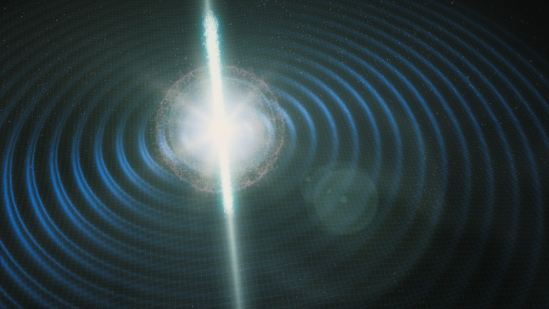Close Quarters Lead to Collaborative Breakthrough
Two at Kavli Institute Discover "Siren" to Measure the Expanding Universe

They say that, sometimes, the universe brings two people together in the same place for a reason. For astrophysics researchers Scott Hughes and Daniel Holz, the place was UC Santa Barbara’s Kavli Institute for Theoretical Physics, and the reason was their work developing the study of gravitational waves, according to an article published in UCSB’s The Current.
During their time as postdoctoral researchers at the Kavli Institute for Theoretical Physics (KITP), Hughes and Holz worked in the same office and frequently discussed their ideas about gravitational waves. But it wasn’t until construction in their building that required researchers to double up in offices that the real collaboration began. Hughes and Holz spent more time with each other developing their proposals about gravitational waves, or the energy carried by a wave propagating through a gravitational field. Two years later they published their study in The Astrophysical Journal.
This July, Holz will lead a program at KITP about his research in gravitational waves and its application to further research on the universe. The event will bring together researchers in relevant fields to examine the most current observations of gravitational waves.
Hughes and Holz’s research organized previous ideas concerning gravitational waves and paved a way for these ideas to be supported through telescope observations of light. In effect, Hughes and Holz helped to discover a new way to determine the Hubble constant, a unit of measurement that describes the expansion of the universe. That’s a positive for astrophysicists — previously, the Hubble Constant could only be measured indirectly and, because of this, was subject to errors and miscalculations.
Hughes and Holz were also the first the use the term “Standard Siren” in describing the gravitational wave phenomena. The term, which they said was coined by fellow colleagues, refers to how wavelengths of light stretch as objects move away from Earth due to the universe expanding. As the wavelength stretches, its frequency drops, similar to how the frequency of an ambulance siren drops as the distance between it and the listener increases.
But even after publishing their paper, Hughes and Holz still had their work cut out for them. The paper showed theoretical proposals for how to measure and use gravitational waves, but at the time of publishing, detections of gravitational waves were not common: More detections were needed to further the research. Holz recalls explaining to colleagues that when gravitational waves would actually be observed was uncertain.
Then in 2017, gravitational wave detectors observed a signal from merging neutron stars, finally giving the research community a new source of gravitational waves. This development launched Hughes and Holz’s research further into the scope of astrophysics, which Hughes carries out currently at Massachusetts Institute of Technology and Holz at Kavli’s institute at the University of Chicago. Standard Siren was becoming a household name among those interested in the Hubble Constant.



